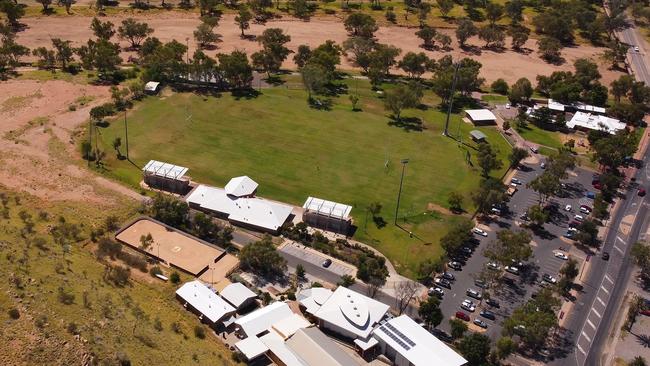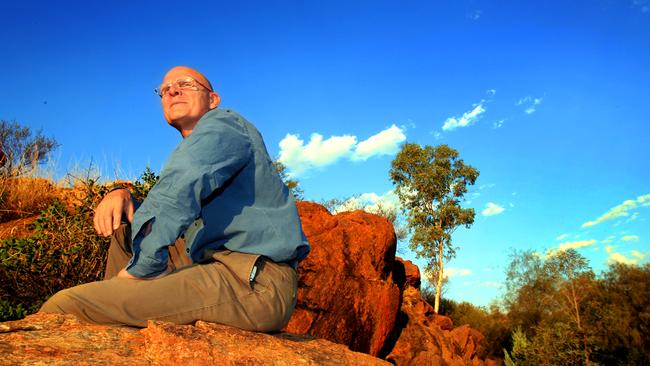Alice Springs secures site for national gallery and $120m federal investment
A controversial site for the much anticipated National Aboriginal Art Gallery has been locked in after years of negotiations. Read why it was selected.
Alice Springs
Don't miss out on the headlines from Alice Springs. Followed categories will be added to My News.
A MEGA investment in Central Australia aims to make it a tourism hub, following the NT government’s acquisition of land for the long awaited National Aboriginal Art Gallery.
The $120m Federal Labor investment in Alice Springs will include funding to reduce crime, improve youth services and build infrastructure that drives tourism and economy.
Initially the oval was rejected by Arrernte Elder Doris Stuart Kngwarreye because of its spiritual significance to Mpartwe custodians.
However, Alice Springs Mayor Matt Paterson publicly confirmed the site along the Todd River at the end of Wills Terrace had been formally acquired.
Tourism Central Australia chief executive Danial Rochford said the project would transform the region’s tourism industry.

“This is going to be a great centrepiece for our community and we’re now really calling upon the Northern Territory government with the support of the federal government to get on, roll the sleeves up and let’s get the shovels out,” he said.
“It will be a great opportunity to showcase national Indigenous culture, truth telling and a great showcase of Indigenous Australian artists.”
The Territory Government has already allocated $50m for the project but the exact funding provided by Federal Labor is still unclear.
Mr Rochford said successful execution of the gallery would be key to its success.
“We’ve certainly been lobbying from day one of this project that this needs to be more than just a regional art gallery,” he said.
“This is a national institution and the design and its curation needs to be at that level.”
The art gallery will be a key pillar of the economic revitalisation of the CBD and is estimated to generate up to 260 direct and indirect jobs during the construction phase.
Once built, the Gallery will support 69 jobs through its operations and up to 245 further jobs throughout the local economy.
KEY INVESTMENT PLANS
The $120m investment is part of a newly released Central Australian plan by Federal Labor which includes other significant investment for roads, healthcare, education, housing, infrastructure and community programs.
During the election campaign Prime Minister Anthony Albanese committed $100m for urgent repairs to First Nations’ homelands and $14m to reduce crime in the red centre.
The $14m for crime prevention will be used for training and support programs and the purchase of CCTV for the CBD, currently only $3m has been released to specific organisations while the remaining funding is yet to be allocated.
The report shows how Labor plans to invest in remote housing and homelands, making a firm promise to renew the National Partnership for Remote Housing Northern Territory which will expire in June 2023.
“We will negotiate a new NT remote housing agreement when the current agreement expires in mid-2023, and we will include homelands in this new agreement,” the report reads.
Critically in the past two remote housing agreements, homelands have been excluded, leaving many people living in dilapidated tin sheds across the Northern Territory.
The report acknowledged homelands as “important places for Aboriginal people,” despite them being “critically underfunded”.
Across health frontline and emergency services will be invested in heavily.
The government has agreed to fund a new Medicare Urgent Care Clinic in Alice Springs to take pressure off the Alice Springs Hospital emergency department.
The bulk-billed service aims to redirect patients with urgent but non-life threatening conditions from hospital into a hybrid primary and secondary care system.
The plan resembles the highly criticised Palmerston Hospital, which has been labelled “pointless” and causing further strain on a stretched health workforce.
The plan appears to cherry pick commitments from across the nation and make them relevant to the Territory.
It acknowledges the need for First Nations health workers in the NT and agrees to train up to 500 nationally, but makes no firm promises as to what that will look like for the Territory’s health workforce which is crippled by shortages post covid.

Central Australian public health clinician Dr John Boffa said the NT has a crisis in GP training as the pool of “registrars” has largely dried up.
“In addition to this, there are not enough nurses or allied health professional being trained to meet demand and this has been known for year,” he said.
“All of these factors have combined to create a perfect storm which means the NT health system is not able to provide anything like the normal levels of care.”
Dr Boffa said the Central Australian Aboriginal Congress had been advocating for range of solutions to the workforce crisis for GPs, nurses, Aboriginal health practitioners and allied health professionals but progress was too slow.
“There needs to be a national summit on workforce that is prepared to make some major systemic changes to the way the health workforce is trained and distributed throughout our nation.”
The federal government though has recognised the vital role air-ambulances play in the Territory where services are sporadic and community are often hundreds of kilometers from urgent care.
As a result it will give $10m to Careflight in order to buy a second NT Air Hospital Rescue Helicopter.
A spokesman for Careflight said the helicopter will increase the Darwin based helicopter’s medical rescue capability and availability and will result in more lives saved.
Despite the helicopter included in the Central Australian plan, there are no plans for it to travel south of the Top End.
There were also significant investments in sporting facilities for Central Australian clubs, including upgrades in Papunya, Hermannsburg, Lajamanu, Yuendumu and Alpurrurulam.
Also announced during the election, Labor has allocated $500m to further upgrade and seal the Tanami Track and the Central Arnhem Road providing Territorians with the access to essential services they need.
The upgrades will help make Territory roads safer and give trucks carrying essentials like food and fuel supplies, greater access to remote communities.




